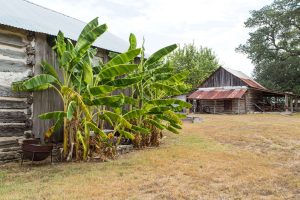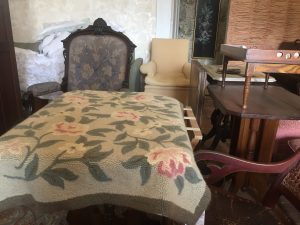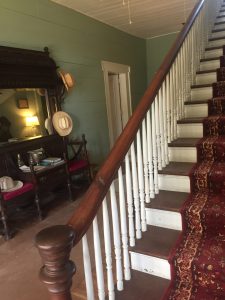Seward Plantation: A Texas Legacy

2024 Spring Antiques Show | March 14 – 31
2024 Fall Antiques Show | October 10 – 27
A more poetic writer might say, “the mists of time shrouded the Seward Plantation as I made my approach in mid-February.” I’m not poetic. It was fog. Dense, landmark-obliterating fog.
Despite repeated assurance from my hosts that I couldn’t miss it, I did. Twice.
I was running late for my 10:00 a.m. appointment, and I was a bit panicked. The estate’s new owners, Wiley and Cynthia George of Houston, were allowing me to witness antiques experts Charlie Ham and Jeremy Teel with Antique Rovers of Montalba, Texas, open a series of historic trunks while preparing the contents for auction.
It was the first time in the plantation’s history anyone outside the Seward family, who built the house in 1855, was accessing the historic possessions. My inner geek was outing herself and going all Antiques Road Show on the prospect of cracking open a six-generation time capsule.
On top of that, I was looking for the stately house I had seen in photos. Somehow, I overlooked the fact that the grand dame already was undergoing a structurally necessary facelift. Scaffolding and raw wood collided with my mental picture.
So did oversized political signs flanking the front gate. Of course, they made perfect sense because Wiley is an attorney, and the signs supported a colleague who was running for the Court of Appeals. If the signs had touted Sam Houston, who lived in the neighborhood and was baptized in nearby Independence Creek, they would’ve fit into my preconceived idea.
Starting over in downtown Independence, the lady at the Independence General Store straightened me out. She also assured me I couldn’t miss it. Either because I was paying attention or because the third time is indeed the charm, I pulled off FM 390 and parked at the intersection of past and present. A mounting block that allowed dress-wearing ladies to ascend to their sidesaddles or step gracefully into a carriage stands alongside the gate.
The front door was ajar, so I poked my head in and heard noise coming from upstairs. I yelled, “Hello, I’m here.” I half expected a Scooby Doo moment with ghosts answering, but fortunately it was Cynthia and Wiley. They broke away from sorting auction items alongside Ham and Teel to show me around their work-in-progress, labor of love.
The sorting, cataloging and choosing is indeed a Herculean labor. They opened the final closet the day before I arrived and discovered 26 lamps. At that time, the couple estimated they had already packed 25 boxes of books, 45 boxes of dishes and décor, rounded up 30 rugs and found at least 25 beds in storage around the property. They hadn’t started going through the outbuildings yet.

Our walkabout was a blur of history, stories, antiques and laughter. In short order I learned the La Bahia Road, a much traveled route connecting east Texas to San Antonio, originally passed directly in front of the house. To accommodate random travelers, the Seward family home included a traveler’s room that could be accessed from the outside but had no interior doors connecting it to the rest of house. It provided rudimentary security. The sick room, which was on the second floor and could only be accessed by an exterior staircase, served the same purpose against the spread of disease.
The artwork adorning the fireplace in the front parlor is the work of Florence Seward, an art student at nearby Baylor University in the late 19th century when it was in Independence. The family opened the upstairs ballroom frequently for student concerts and dances. Florence died in an equestrian accident at the age of 18, long before she graduated from college.
In the foyer an original framed sign touted the availability of Edison electricity. A string stretched from the upstairs fixture into the foyer, so family members could turn the light on or off from either level. It had hung so long that the well-used convenience had worn a groove in the banister.

A dresser in the traveler’s room purportedly belonged to noted, radical prohibitionist Carrie Nation. Another room revealed a Civil War era rifle, a canteen marked with an “S” and a fireman’s belt the family suspects belonged to Sam Seward, who was a veteran of the Battle of San Jacinto. The powder horn is his.
Military service was a common thread in Independence. Jerome Bonaparte Robertson, who rose to the rank of brigadier general in the Confederate Army as part of the Fifth Texas Infantry and succeeded John Bell Hood as the commander of the famed Hood’s Brigade, lived just down the road.
We descended into the basement where Ham and Teel began opening the World War I trunks belonging to Col. Oscar Seward, Jr., who was also an engineer of note. Some revealed the expected WWI issue: Red Cross medical gowns, army uniforms and equipment such as holsters, but others contained vintage women’s fashions from the 1920s and the 1940s, and others contained assorted things that someone sometime deigned to store. The original bathtub, which was a huge zinc-lined, cypress tub, sat atop a pile of life’s ephemera. A box of vintage shoes rested next to replacement slats for the original shutters. A discarded computer mouse peeked out from beneath the basement steps.

The grounds, with a smoke house, slave quarters, corn crib, blacksmith shop and the original log barn and hay mow, reiterate the estate’s uniqueness. Plantations with surviving outbuilding are rare in Texas. The majority of these buildings are crafted from old-growth cedar logs measuring at least 12 feet long and with a girth that dwarfs the spindly cedars that serve as native Christmas trees. These massive timbers were hand hewn by slaves in an era where that was the norm.
In 1934, the plantation was the site of a Historic American Buildings Survey, which documented the homestead including the outbuildings. In the late 1990s, Hank Ward, a Seward descendant, restored the slave quarters. Texas A&M conducted a two-year study of the outbuildings in which experts documented the site. The Georges hope to work with the university again, in particular to help restore the historically significant barn.
Piles of split rails from earlier generations lie in wait to replace sagging fences. A 10-speed bicycle rests against a wagon frame. Oxen yolks hang haphazardly. Farm equipment from every era is evident including an old hand-crafted ax that purportedly was used to harvest the original timbers. The Georges found four hand plows under the front porch.
As I was preparing to leave, the sun broke through the clouds and burned off the smothering fog. The plantation shimmered in the promise of a bright new day.
To learn why Cynthia and Wiley George are committed to conserving the plantation, click here. To read more about the auction at the plantation hosted by Antiques Rovers click here.
________________________________________________________________________
by Lorie A. Woodward
photos by Cargile Photography
2024 Spring Antiques Show | March 14 – 31
2024 Fall Antiques Show | October 10 – 27